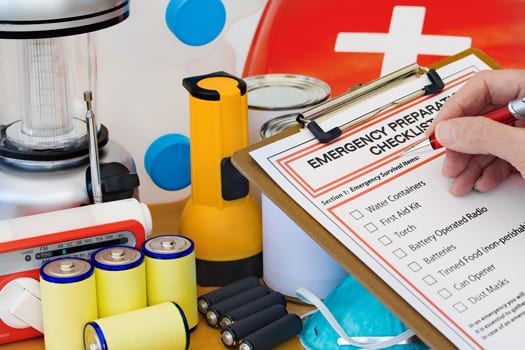June 1 marks the beginning of hurricane season. Meanwhile, across much of the Western U.S., major droughts have greatly increased the danger for summer wildfires. And don’t forget last winter’s record-breaking winter storms – or the ongoing potential for earthquakes, tornados, floods and other natural disasters.
Such catastrophic events are inevitable, largely unpreventable and often strike without warning. Even though we can’t always predict natural disasters, we can anticipate their likely aftermaths, including property loss, power or water service disruption and scarcity of food and supplies.
Sit down with your family and develop a disaster plan.
By planning ahead and knowing what you might need under dire circumstances, you can save yourselves a lot of time, money and grief.
Resources for Disaster Preparation
FEMA, the Federal Emergency Management Agency (www.fema.gov), offers great suggestions for developing a family emergency plan, building an emergency supply kit, and learning what to do before, during and after emergencies (everything from home fires to terrorist attacks). They even provide an emergency plan for family pets.
These resources are also valuable in disaster preparation:
- https://www.ready.gov/
- http://www.nhc.noaa.gov/prepare/ready.php
- http://www.nationalgeographic.com/environment/natural-disasters/hurricane-safety-tips/
- https://www.redcross.org/get-help/disaster-relief-and-recovery-services/recovering-financially.html
If you are in the path of a powerful storm, take steps to prepare for the storm:
- Evacuate if you can.
- Buy water and nonperishable food in the event that utilities are disrupted by the storm.
- Charge your phone and computers. In the absence of a generator, a fully charged laptop or tablet can be used to recharge a phone.
- Fill your cars with gas.
- Secure your outdoor items, either by bringing them inside or weighing them down with sandbags. If you can’t get sandbags, fill garbage bags with dirt.
Here are some emergency-planning ideas you may not have considered:
- Pick meeting spots both in and outside your neighborhood where your family can gather after an emergency.
- Choose one person (possibly out-of-town) everyone can contact for updates.
- Make sure your kids know how to escape the house in case of fire.
- Identify and stock essential items you’ll need to survive for at least three days in case help is unavailable. Include ample water (at least a gallon per person, per day), non-perishable food, and medications. Don’t forget water, food and supplies for pets.
- Stock an emergency kit with batteries, flashlight, a battery-powered or hand-cranked radio, water-purification tablets, clothes, blankets, can opener, tools, toilet paper, moist towelettes, garbage bags, solar cellphone charger, etc.
- If a family member receives life-sustaining treatments (e.g., dialysis), identify alternate treatment locations in case yours becomes incapacitated.
- Take a picture of yourself with your pets in case you should become separated.
- Safely store emergency cash in case ATMs aren’t working.
Should disaster strike, you’ll need access to financial and legal records. Take these steps now to ensure easier access when the time comes:
- Create a log of all account numbers, emergency numbers, contact information and passwords for your bank and credit card accounts, loans, insurance policies, utilities and other important accounts.
- Update it regularly and save hardcopies in secure, offsite locations such as a safety deposit box or with a trusted friend living in another area.
- You can also email the list to yourself in an encrypted, password-protected file, save it on a CD or USB drive, or use a cloud-based storage service that will let you access it from any Internet connection.
- Make PDF copies of tax returns, insurance policies and legal documents and save offsite, as above, in case your files or computer are damaged. Also make digital copies of invaluable family photos, documents and memorabilia that money can’t replace.
Resources for Natural Disaster Victims
Federal Relief
- USA.gov financial assistance – https://www.usa.gov/disaster-financial-help
- FEMA disaster declaration – https://www.fema.gov/disasters
- Government Disaster Assistance – https://www.disasterassistance.gov/
- Benefits.gov disaster relief – https://www.benefits.gov/benefits/browse-by-category/category/14
- IRS tax relief in disaster situations – https://www.irs.gov/uac/tax-relief-in-disaster-situations
- USDA disaster assistance programs – https://www.fsa.usda.gov/programs-and-services/disaster-assistance-program/index
- A.gov financial assistance after a disaster – https://www.usa.gov/disaster-financial-help
- VA guidance on natural disasters – https://www.benefits.va.gov/homeloans/documents/docs/va_policy_regarding_natural_disasters.pdf
- Student disaster aid – https://studentaid.ed.gov/sa/about/announcements/disaster
- US211 disaster assistance – http://www.211.org/services/disaster-assistance
- Disaster recovery – http://texashelp.tamu.edu/browse/disaster-recovery-information/
Charitable Relief Organizations
- American Red Cross Harvey donations – https://www.redcross.org/donate/donation.html/
- American Red Cross get disaster help – http://www.redcross.org/get-help
- Salvation Army disaster relief services – https://disaster.salvationarmyusa.org/aboutus/?ourservices
Insurance Companies
- Allstate Insurance catastrophe assistance – https://www.allstate.com/catastrophe/catastrophe-team.aspx
- State Farm Insurance disaster response – https://www.statefarm.com/about-us/community/safety-awareness/disaster-response
- Travelers Insurance catastrophe response – https://www.travelers.com/claims/catastrophe-response/index.aspx
- Farmers Insurance catastrophe response – https://www.farmers.com/catastrophe/alert/
Housing and Mortgage Assistance
- Freddie Mac loan lookup – https://ww3.freddiemac.com/loanlookup/
- Freddie Mac general disaster policy (scroll down the page to the tab) – http://www.freddiemac.com/singlefamily/service/
- Freddie Mac managing distressed properties – http://www.freddiemac.com/learn/pdfs/service/dis_prop.pdf
- Freddie Mac disaster relief FAQs – http://www.freddiemac.com/singlefamily/service/faq.pdf
- Fannie Mae loan lookup – https://www.knowyouroptions.com/loanlookup
- Fannie Mae general disaster policy (scroll down) – https://www.fanniemae.com/content/guide/servicing/d/index.html
- Fannie Mae disaster assistance – https://www.fanniemae.com/singlefamily/disaster-assistance
- HUD general disaster resources – https://portal.hud.gov/hudportal/HUD?src=/info/disasterresources
- HUD disaster recovery and emergency preparedness toolkit for housing counseling programs – https://www.hudexchange.info/programs/housing-counseling/topics/#disaster-recovery-toolkit
- HUD Housing Counseling Disaster Program Guide – https://www.hudexchange.info/resources/documents/Housing-Counseling-Disaster-Program-Guide.pdf
Business Owners
- SBA disaster loan assistance – https://disasterloan.sba.gov/ela/
Legal Aid
- Legal Aid by state – http://www.ncsc.org/topics/legal-services/legal-aid-pro-bono/state-links.aspx
Insurance Claims for Natural Disasters
If you ever need to file an insurance claim or claim a tax deduction for lost, stolen or damaged property, it’ll be much easier if you have an inventory of everything you own – photos or videos are even better. Try the Insurance Information Institute’s free, secure home inventory software application (www.iii.org).
Also, investigate what is and isn’t covered by your insurance policies for natural disasters. You may need additional coverage for damage associated with hurricanes, tornados, earthquakes and other weather conditions.
Bottom line: Having a family emergency plan in place could lessen the blow should disaster strike.

5 MINUTE READ
Home » InCharge Blog »

















